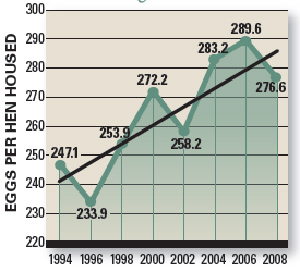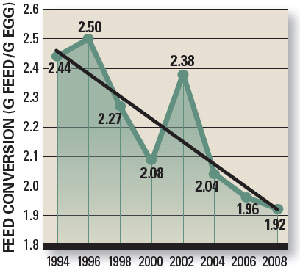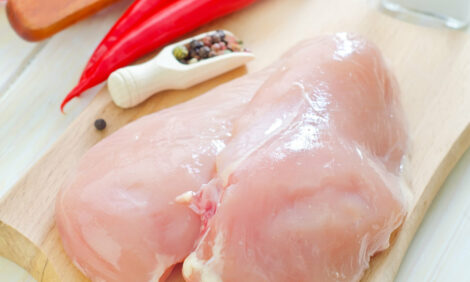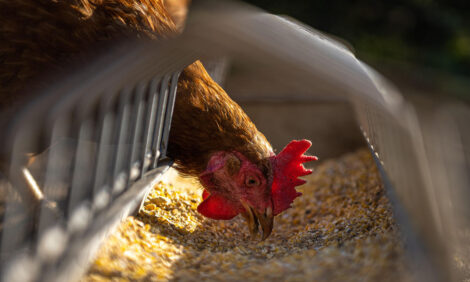



A Geneticist's Perspective: What Are the Traits that Further Sustainable Production?
An outline of selection structure, sustainable traits and measuring genetic progress in egg production and feed conversion by Dr Neil O'Sullivan of Hy-Line International.Genetics companies sit at the apex of a pyramid of livestock production and are constantly improving the genetic potential of the next generation of animals. Therefore genetic companies must weigh seriously the current demands of the marketplace and predict future demands of the consumer. Genetic improvement relies on measurements of phenotypic traits in pureline and crossbred progeny of pureline animals to evaluate the genetic potential of these animals under commercially relevant environments.

The best animals are selected on the basis of these evaluations to reproduce the next generation and to multiply out these genetic improvements to the livestock industries they serve.
In the egg layer industry, we select on a large group of traits, divided into five trait groups, namely production, egg quality, efficiency, animal wellbeing and reproduction. Many of the individual traits within these trait groups have a direct impact on the sustainability of production of eggs as food. Egg layers are among the elite of animal agriculture production systems in terms of their sustainability, with their low carbon footprint, high reproductive rate and most importantly, their high yield relative to low input costs.
Selection Structure
Pedigreed populations, both pureline and crossbred progeny are evaluated for more than 30 different traits in individual animals and in group environments, each and every generation. Only a small percentage of the very best animals with the highest genetic value will be multiplied to produce future production stocks and to perpetuate the pureline themselves.
Such a rigorous system needs very high throughput evaluation systems with high accuracy and repeatability of each measurement taken. Today, the phenotype evaluation is accompanied by more and more genotype information from DNA markers such as microsatellite and single nucleotide polymorphism which have been validated to show an association with differences in a trait's performance.
So selection decisions are now made based on a triangulation of data from pureline, crossbred and DNA marker data points. This use of multiple data sources and complex pedigrees over multiple generations requires very large computing power also.
Today, egg layers are evaluated in breeding programmes where crossbred birds are measured under commercial conditions. This allows very good group performance data evaluation for behaviour traits. These traits are important from a sustainable perspective, avoiding feed and water wastage, feather cover of the hens, low social stress and livability related traits along with efficiency traits' direct impact on sustainability.
The trait groups are production traits which include sexual maturity, peak rate of lay, persistency of egg production and post-moult rate of lay.
The animal well-being trait group include livability of pullets and adult layers, specific disease resistance such as Marek's disease, feather cover, social behaviour, reducing fear and nesting behaviour. The quality trait group includes, shell strength, freedom from cracks, shell colour, albumen quality, egg size, yolk weight, percent solids in eggs and freedom from blood or meat spots.
The efficiency trait group includes residual feed intake, group bird performance, low feed wastage, dry manure, and low maintenance body cost.
The reproductive trait group includes fertility, natural mating ability of males, hatchability, sperm count and sperm mobility.
Sustainable Traits
Productivity, number of eggs laid and eggs of saleable quality are key factors in sustainable egg production. Livability is a sustainable trait as spreading pullet capital costs must be done over long-lived, viable and productive animals.
Nutrition of the egg is a factor in sustainable egg production as egg quality and especially the percent yield of egg solids and albumen quality, play a key role here.
The kilos of feed needed to produce a kilo of eggs is obvious as a sustainable trait, however, low feed and water wastage as well as complete feather cover all have roles in this trait.
The social behaviour of the animals with low dominance drive, low cannibalism and wastage due to social stress are all necessary to factor in along with the use of nests by the birds.


Measuring Genetic Progress
In the graphs above, we see continued year-over-year improvement in genetic stocks of Hy-Line Brown.
Clearly from data on public tests such as the North Carolina Layer Performance and Management Tests, long-term progress can be seen for feed efficiency and eggs per hen housed.
When we look to animal protein prices to the consumer, we see eggs are the most affordable, followed by poultry meat and other meats. It is obvious the genetic trends show no sign of loss of progress over time.
This article was first published in International Hatchery Practice.
August 2011








